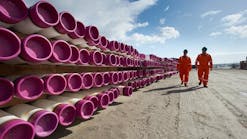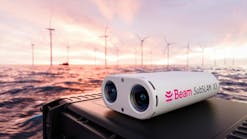Atkins provides holistic approach to managing assets
Ted Moon - Technology Editor
Energy companies demand more from their producing assets than ever. As a result of high oil and gas prices and ever-growing demand, companies face the task of keeping their producing infrastructure, from below ground to the platform to the beach, running efficiently and sometimes longer than its original design life.
As a consequence, there is a growing need to closely manage the operational integrity of each piece of equipment to lower the risk of unexpected stoppage, which translates to a growing need for capable consultancy firms. Companies such as the Atkins Group fill that need.
The UK-based consultancy group has a global reach, but one of the fastest-growing regions for the company is Trinidad & Tobago. Atkins moved into the country in 2000 (when it was known as MSL Engineering) as a result of its successful collaboration in the US with BP (formerly Amoco). The energy giant saw a need for experienced consultants to help manage its large production infrastructure of offshore platforms and pipelines.
FMS minimizes risk
As Justin Bucknell, director of Atkins’ Oil and Gas Americas Group, explains, Atkins has designed Web-based, risk management software systems that allow clients to have a holistic view of the integrity of entire systems. One such software program is called the Fleet Management System (FMS), which was developed with BP, where it is branded bpFMS, to assist in risk-based integrity management work.
“FMS allows operators to optimize their expenditures on inspection, maintenance and repair, and allows them to budget the proper amount of both money and time,” says Bucknell. “It allows operators to focus resources on more critical areas which would severely impact their operations should they fail.”
FMS is not only a powerful database, but is also an engineering tool that tracks maintenance schedules and performance trends, and makes adjustments and recommendations as new operational information becomes available.
Bucknell explains this in more detail with an example. “Let’s say a significant dent is found in an offshore structure. FMS will evaluate the dent information and will determine if it is significant to the operation of the structure.
“If there is risk associated with the dent, FMS will readjust the overall risk associated with the structure, and in addition will adjust the inspection plan and update the interval for the next inspection.”
Bucknell further explains that Atkins and client engineers will be able to use this risk assessment from FMS to make decisions about whether to replace damaged components, and how long they can reasonably expect the component to continue working safely and reliably.
The power of FMS has attracted attention outside of BP, and it is now used in Trinidad & Tobago by companies including BG, EOG, Repsol, and state-run Petrotrin, to name a few. Engineering support around FMS-based services has become one of the major areas of work for Atkins engineers in the country.
Incorporating weather events
Another recent major focus for Atkins is the Graphical Information System (GIS), where Atkins played a significant role in the BP developed GIS interface to bpFMS. GIS gives the operator a graphical view of all its assets in Trinidad. “GIS maps in all platforms, pipelines and wells,” Bucknell says, “and allows you to share a lot of views and information in the same environment.” BP plan to use the GIS environment for demonstrating the structural integrity of their Trinidad platforms through the link to bpFMS.
Bucknell says that GIS sets up a collaborative environment that allows an operator to assess potential weather-related threats to operating facilities and structures in real-time. “An oceanographer can import wind and wave data into the picture, a meteorologist can bring in weather data, and an engineer can import asset risk data from FMS.
“When you spatially query these three components, you have access to a great deal of information.”
Other associated structures, such as weather buoys and helipads, also can be brought into GIS. “Anything web-based can tie in real-time,” says Bucknell.
According to Bucknell, GIS also provides a means to track hurricanes moving into the region as part of an emergency response plan and post hurricane incident response. One important component of post hurricane activity, locating floating assets that may have broken free of their moorings, can be greatly aided by using GIS.
Atkins not only is adding more clients to its roster with these software solutions, but also plans to add more in terms of services. For example, decommissioning is receiving growing attention in Trinidad, and Atkins is preparing to help companies with assets near the end of their economic life cycle. The GIS tool can be used to identify suitable locations for placing of decommissioned structures at designated sites to develop artificial reefs similar to the successful ‘rigs to reefs’ program in the US Gulf of Mexico.
“In addition, we have had a lot of support from clients to link lessons learned from integrity management once the asset is up and running to the design phase up front - basically to design out the problems in the first place,” says Bucknell.
Atkins’ services have influenced customers such as BP in their design decisions at the outset of a project. Pat O’Connor, Senior Advisor, Structural and Offshore Engineering for BP, sees services such as these as an integral part of Performance-Based Design (PBD). “We know conditions offshore Trinidad are very corrosive to begin with,” O’Connor says, “so we don’t want to wait until the onset of a problem to do something about it.
“By planning for corrosive conditions up front, we can eliminate the need to conduct potentially dangerous and costly shut-downs and repairs of gratings and hand rails on a regular basis, often with fairly insignificant amounts of extra investment up front. The typical preventative investments to be made are noise in the overall project cost.” Another PBD opportunity is the reduction of diving activities for reduced cost and increased safety by using technology and experience to design more efficient structures with underwater inspections reduced to a minimum using risk based integrity strategies. O’Connor states “this leads to the BP equation ‘VALUE = TECHNOLOGY + EXPERIENCE’, the fundamental basis of PBD.




